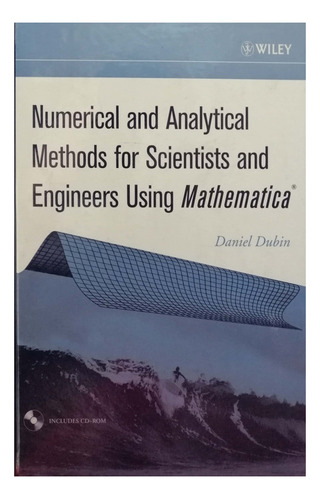Numerical And Analytical Methods For Scientists Engineers
en 12x sin interés
Llega el martes
Retira a partir del martes en servicios de encomiendas y otros puntos
Ver en el mapa¡Última disponible!
Conoce la


Características principales
Título del libro | Numerical and Analytical Methods for Scientists and Engineers using Mathematica |
|---|---|
Autor | Dubin, Daniel |
Idioma | Inglés |
Editorial del libro | Wiley-Interscience |
Edición del libro | 0.0 |
Tapa del libro | Dura |
Con índice | Sí |
Año de publicación | 2003 |
Otras características
Cantidad de páginas: 640
Altura: 26 cm
Ancho: 18.5 cm
Peso: 1340 g
Con páginas para colorear: No
Con realidad aumentada: No
Género del libro: Cienciass Puras
Tipo de narración: Manual
Tamaño del libro: Mediano
Accesorios incluidos: Si
Edad mínima recomendada: 18 años
Edad máxima recomendada: 99 años
Escrito en imprenta mayúscula: No
Cantidad de libros por set: 1
ISBN: 9780471266105
Descripción
LIBRERÍA LEA+
Practitioners in the field of physical science are continually faced with a variety of complex, real-world problems, the solution of which requires a working knowledge of both analytical and numerical techniques. An Introduction to Mathematical and Computational Physics Using Mathematica® is designed to help prospective scientists develop a practical, working knowledge of these techniques using the latest, most efficient electronic methodologies.
Written from the perspective of a physicist rather than a mathematician, the text focuses on modern practical applications in the physical and engineering sciences, attacking these problems with a range of numerical and analytical methods, both elementary and advanced. Incorporating the widely used and highly praised Mathematica® software package, the author offers solution techniques for the partial differential equations of mathematical physics such as Poisson's equation, the wave equation, and Schrödinger's equation, including Fourier series and transforms, Green's functions, the method of characteristics, grids, Galerkin and simulation methods, elementary probability theory, and statistical methods.
The incorporation of Mathematica® offers students a wealth of practical benefits in that it:
- Requires little or no previous computer experience
- Offers maximum flexibility and sophistication
- Delivers easy access to the important ideas behind the various numerical methods
- Facilitates important but often tedious analytic calculations
- Is easily adapted to the application of other related software packages
Designed for both advanced undergraduate and graduate students in the physical and engineering sciences, as well as professionals who want to learn these methods, An Introduction to Mathematical and Computational Physics Using Mathematica® is also provided electronically on an accompanying website. The electronic version contains the full text of the book, along with animations, user-modifiable source code, and links to related Web materia
----------
¡Cuéntanos si necesitas más libros y podemos publicar un PACK A TU MEDIDA, para que AHORRES en gastos de envío! Necesitamos saber el título y autor para ver disponibilidad.
